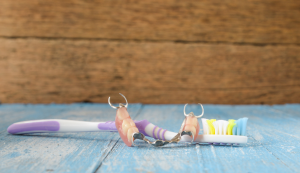Partial Dentures: What You Should Know
 Partial dentures are an option to replace one or more missing teeth. Implants are the most ideal tooth replacement option, but individual implants can be expensive. Pulling healthy teeth to place a full denture is never recommended. Partial dentures allow you to eat normally and restore your smile, but not all partial dentures are the same. You and your dentist will work together to determine the right solution for you.
Partial dentures are an option to replace one or more missing teeth. Implants are the most ideal tooth replacement option, but individual implants can be expensive. Pulling healthy teeth to place a full denture is never recommended. Partial dentures allow you to eat normally and restore your smile, but not all partial dentures are the same. You and your dentist will work together to determine the right solution for you.
Types of Partial Dentures
Partial dentures come in two types: fixed and removable. The type of partial denture that is right for you depends on many factors, including the health of your surrounding teeth, your budget, and your goals for treatment.
Also known as a dental implant bridge, a fixed partial denture gets its name from the fact that it is permanently attached to either implants or natural teeth. Dental implants made of biocompatible titanium are embedded beneath the gum line, where they osseointegrate with the jaw bone. Then, a bridge of artificial teeth is secured to the implants. Depending on the structure and condition of your mouth, a long run of missing teeth can be secured with just a few implants. This solution is more expensive than a removable partial denture, but less costly than a mouthful of individual implants and crowns.
Removable partial dentures come in several different styles. All consist of artificial teeth that are secured with clips or clasps to your existing healthy teeth. An acrylic partial denture, known as a flipper, is generally considered a temporary option, as it tends to be bulkier and less comfortable than other types of partials. The most common long-lasting partial denture is made of a cast metal framework that supports high-quality replacement teeth and uses precision attachments to improve aesthetics. Flexible partial dentures are comfortable and realistic-looking, but generally do not last as long as cast metal partials. Your dentist will help you decide which is best for you.
Benefits of Partial Dentures
Both fixed and removable partial dentures have quite a few benefits over leaving gaps in your mouth. These include:
- Improved chewing and speaking
- More natural and beautiful smile
- Reduced sagging and premature aging of the face
- Decreased risk of gum disease
- Preventing your remaining teeth from shifting around
- Lowered jaw stress and tension
Caring for Partial Dentures
Like your natural teeth, partial dentures need to be brushed carefully on a regular basis to remove plaque and food residue. Unlike your natural teeth, however, partial dentures are prone to breakage and damage. Here are some tips for keeping them clean without messing them up:
- When handling removable dentures outside of your mouth, always hold them over a folded towel or lean over the sink
- Use a soft toothbrush or specially designed denture brush
- Never use bleach or any other type of household cleaner on dentures
- When you are not wearing your partial denture, soak it in a denture cleanser
Partial dentures are an excellent choice for replacing missing teeth. However, not all partial dentures are alike. You and your dentist will work together to choose the best solution for your individual needs.
Conveniently located in Woodbury, MN, Creekview Dental provides a progressive yet conservative approach to dental care. Our innovative, highly personalized procedures are focused on maintaining tooth structure and providing you with the healthy, beautiful smile you deserve. Call us today at 651-738-8204 to take the first steps on the road to better dental health.

